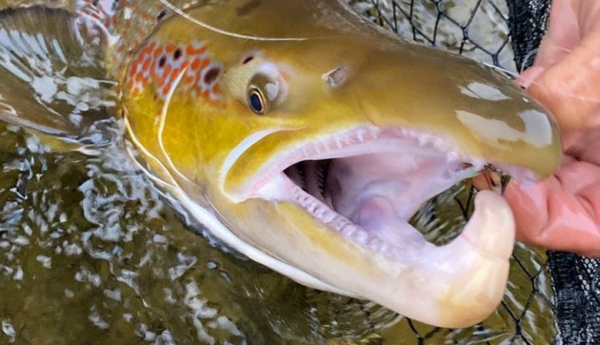Salmon Mysteries from the Atlantic Salmon Federation
 |
Late season male Cascapedia salmon showing the triangle-shaped teeth and well developed kype. Photo Dan Greenberg
In the natural history of Atlantic salmon, mysteries get piled upon mysteries. When these fish are at sea, they have needle-like teeth that are perfect for grabbing prey, whether capelin, young boreo-atlantic armhook squid, or other prey.
But when the Atlantic salmon return to freshwater, those teeth fall out, and they grow an entirely new set of teeth that are triangle-shaped.
The reason is not known, except it likely goes back to a previous need at some point in their evolution. The puzzle deepens with the fact that Atlantic salmon do not eat when they return to fresh water. In fact in some situations such as in the Kola River in northwest Russia, the salmon can go as long as 22 months without eating. So, why the teeth?
A related question is where the Atlantic salmon get the calcium that goes into the building of these triangle-shaped teeth, as well as calcium needed for the bone needles that form the structure of the kype and bulbous nose in the males since they are not eating. The calcium needed is reabsorbed from the scales, an elegant solution to a changed need of the fish.
Just one more mystery of a species that is charismatic partly because it is so rich in mysteries.
Incidentally, a reminder that while Atlantic salmon can survive the rigours of spawning when the Pacific salmon species do not, it isn't every Atlantic salmon that is able to go on to return to the sea, either immediately or after a winter spent in freshwater. The rate of survival to return to the ocean will vary from river to river, and likely also in the yearly conditions. One might project that it would be no surprise to have a lower survival this year in the multitude of watersheds that continue to have low water. The effort required to reach spawning areas and to conduct the spawning activities is bound to reduce the survivability of the fish.
As to actual survival, it should be no surprise that after a migration of 3,000 km, and adversity in freshwater, perhaps 30 per cent are able to survive and become "kelts".
Exploring the facts of life and survival of wild Atlantic salmon is part and parcel of being a 21st century Atlantic salmon conservationist. Atlantic salmon have still more mysteries to be unravelled, and there are many surprises along the way.
See more like this and join the Atlantic Salmon Federation to support salmon conservation at https://www.asf.ca/news-and-magazine/river-notes/asf-rivernotes-8-oct-2020


 Advertising
Advertising